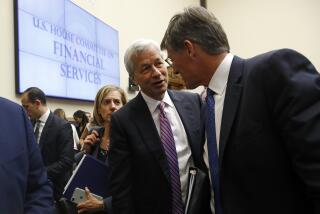Bill Simonâs Silent Partner Is the Taxpayer
William E. Simon, former Secretary of the Treasury and a highly successful investor in recent years, is investing these days in money-losing or even insolvent savings and loan companies--that is, in some of the worst casualties of what may be the most troubled industry in the United States.
Yet such is Simonâs reputation that it is assumed he has some special insight and will make a fortune in S&Ls;, as he did most memorably in 1982 when his Wesray partnership bought Gibson Greeting Cards for $80 million from the old RCA Corp. and sold it in a public stock offering 16 months later for more than $300 million. The Wesray partners, Simon and investor Ray Chambers, put up only $1 million in equity in that deal and thus made a profit of better than 200-to-1. It was the kind of score that ordinary investors dream of and admire.
Now Simon has moved on from Wesray and joined Preston Martin, former vice chairman of the Federal Reserve and one-time head of the Federal Home Loan Bank--which regulates savings and loans--and Gerald Parsky, a Los Angeles lawyer and Simonâs old aide at Treasury, in a new partnership that has attracted funding from Australian and Italian investors.
Financial Mosaic
The plan is to use S&Ls; as a base for financing ventures around the Pacific Rim. The Simon partnership acquired money-losing Honolulu Federal Savings & Loan last year and, with the governmentâs help, recently acquired Bell Savings & Loan of San Mateo, and Southern California Savings of Beverly Hills. The latest news is that the partnership is talking to the government about acquiring Financial Corp. of America, the $34-billion (assets) holding company for American Savings, the nationâs third-largest S&L;, which has a high level of problem loans.
It is from properties like those that Simon envisions a âmosaic of financial institutionsâ doing business among the growing Pacific nations.
Howâs that again? Troubled S&Ls;, Australian and Italian money, financing for the Pacific Rim? Has Simon, 59, a one-time Wall Street bond dealer, been reading too many âTales of the South Pacificâ? Not likely. The scheme may never achieve its vast ambitions, of course, but it is founded on shrewd insights: that with leverage you can risk a little, make a lot; that there are opportunities in a changing industry, and that in troubled situations like the S&L; business, government makes the taxpayer your silent, and well-heeled, partner.
A Different Animal
Leverage first: Everybody who owns a house or condo understands leverage. If you buy a $100,000 house for $10,000 down plus a $90,000 mortgage, and the house appreciates to $110,000, you have made 100% on your equity even though the house has appreciated only 10%. Simon employs leverage on a grand scale. In Honolulu Fed, he and his partners acquired Hawaiiâs largest S&L;, with $1.7 billion in assets, by putting up only $17.5 million in equity, although they also helped to secure $40 million in âjunk bondâ financing for the ailing S&L.;
Changing industry: The S&L;, which used to make and hold mortgages, is becoming a different animal--a financial services firm that originates and pools mortgages and sells them into the mortgage-backed securities market. Its new business combines banking with Wall Street-style securities underwriting.
And the S&L; has advantages over both banks and Wall Street, says Kenneth Thygerson, former head of the Federal Home Loan Bank and now president of San Diego-based Imperial Corp. of America. The government allows S&Ls; to operate with lower capital reserves than the banks, he points out, and the S&Ls; have an advantage over Wall Street investment houses, too, because they can raise money through government-insured deposits.
OK, but why are Simon and his partners buying troubled S&Ls;?
Because the government helps them, of course. Simon and partners invested $43 million--$35 million from Australia--to acquire $1.3-billion (assets) Southern California Savings, while the government put in $218 million to shore up the companyâs capital. If Simon goes forward with Financial Corp. of America, the government will shoulder the cost of working out the companyâs bad loans--what Parsky calls âthe burdens of the past.â
Why? Because the Federal Savings & Loan Insurance Corp.--which insures the first $100,000 of all deposits--is practically broke and the government canât afford to let the ailing S&Ls; fail. Congress is voting $5 billion to $7.5 billion in emergency funds for the FSLIC, but even that much would vanish in a flash if outfits like FCA--with at least $3 billion in bad loans--went under.
So Simon and the old S&L; regulator, Martin, are Johnnies-on-the-spot, helping the government to keep the S&L; doors open while the government helps them to put together a growing financial services company.
Call it taxpayer-assisted free enterprise. As former government servants Simon, Martin and Parsky might put it: You couldnât find a better partner.
More to Read
Inside the business of entertainment
The Wide Shot brings you news, analysis and insights on everything from streaming wars to production â and what it all means for the future.
You may occasionally receive promotional content from the Los Angeles Times.








